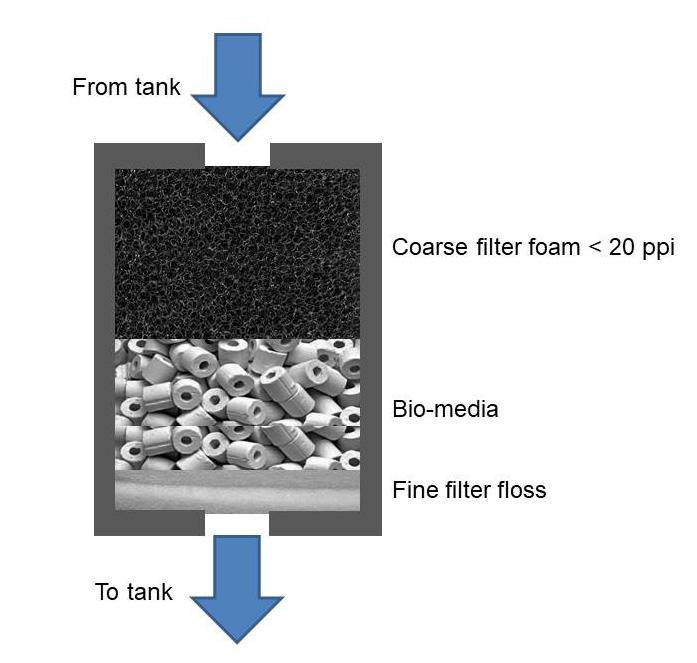
General approach
Bio media is the designated layer where bacteria is allowed to thrive and build up over time. These bacteria breakdown organic waste and also oxidizes harmful ammonia into relatively benign nitrates. This layer should not be disturbed as it takes a long time for bacteria to colonize filter media.
Thus the bio media layer should be shielded from debris so that it does not clog up – bio media requires good flow through it for aerobic bacteria action to be effective. A sponge media layer usually acts as the shield, capturing coarse particles that might otherwise easily clog up the bio-media and can be washed/replaced often without disturbing the bacteria in the bio media.
Both sponge and ceramic media can play the role of bio-media for bio-filtration. The main advantage of ceramic media is its durability and that it does not collapse. Specially designed ceramic media can provide regions for anaerobic bacteria action – which allows for reduction/removal of nitrates. Sponge media is significantly cheaper, lighter as a whole. Very fine filter floss/sponge can be used to capture fine particles in the water to give high water clarity.
Basic layout
A basic filter layout would be as such:
- First stage consists of some form of coarse mechanical filtration media to capture large sized particles and prevent debris from clogging up the rest of the filter. This layer is meant to be rinsed out regularly during servicing. There can be a surprising amount of organic debris in a planted aquarium. Smartly designed filters such as the Oase Biomaster series (read here for review) have a separate pre-filter compartment that can be removed and cleaned without taking the whole filter apart.
- Second stage consists of biological media; whether using ceramic media or filter sponges/large surface media as a home for bacteria colonization. This is where ammonia cycling takes place and bacteria digests organics waste into less harmful substances. This layer should not be disturbed often; if it gets clogged easily it is a sign that the coarse filtration media (first stage) is not doing its job.
- Last stage consists of smaller pore filter foam; this acts to capture fine particulate matter before water is returned to the tank. Some tanks do fine even without this stage. Alternatively one can use fine filter floss, which clogs easily but captures very fine particles, many folks may bypass it just to reduce maintenance.
There can be many more intermediate layers in between in many setups, as people choose layers that suit their particular setup.
Using purigen/carbon in layout
Purigen, if used, should be placed at the end of the chamber to capture the finest particles before water re-enters the tank. It needs to be bleached regularly to recharge it.
If the concern is water polishing, rather than just use one layer of coarse filter sponge, a medium grade filter sponge is placed after the coarse sponge. This captures smaller particles and prevents particulate matter from clogging up the bio-media/fine filter floss.
My layout in filters with pre-filter chambers
This is the layout that I use in most of my tanks. I use filters that have fine filter sponges as a pre-filter; these pre-filters are great at removing debris, which allows the entire main chamber (as above) to remain untouched for months (about 4 to 6 months). Occasionally I use purigen in my tanks as well.


